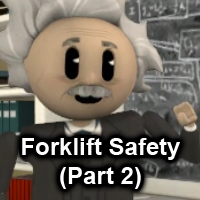Thanks for joining us for Part 2 of our coverage of forklift safety. If you missed Part 1 on forklift safety, be sure to check it out. Today, we’ve got more forklift safety tips from The National Institute for Occupational Safety and Health (NIOSH). These tips will tell you exactly how to avoid forklift accidents from happening in your warehouse.
It is important to realize just how dangerous forklift accidents can be, so we’ve included some more Case Reports below. Thankfully, you can avoid these types of accidents by practicing our forklift safety tips in your warehouse.
- In April of 1995, a 37-year-old foreman was injured fatally by an overturned forklift he was operating. He was backing down a slight incline while transporting 150 pounds of materials when he attempted to turn the forklift which tipped the vehicle. The forklift did not have a seatbelt, and no one else was present to witness the accident.
- In September of 1997, a 61-year-old man was killed after falling 7 feet from an unsecured platform elevated by a forklift. While trying to remove a light bulb, the victim stepped too far to the edge of the platform, causing the platform to topple and fall off of the forks. After falling and striking his head, the victim was then crushed by the falling platform, killing him.
- In September of 1995, a 47-year-old warehouse manager was moving tires onto a wooden pallet he was standing on while elevated 16 feet above the ground by a forklift. The pallet became unstable from the weight of the tires he was loading, and the manager fell and struck his head fatally.
If you never want to witness an accident similar to those described above, we recommend you follow the safety guidelines we’ve covered in this video, and the video from Part 1. For many operations, forklifts can be replaced by lighter material handling equipment like pallet trucks and pallet stackers to avoid serious injury. Check out the rest of our warehouse safety blog for more safety guidelines and information. We’ll see you next time!
Forklift Safety Video Transcript
 Hello. We’re here to talk about forklift safety, so let’s get right down to the most important facts. Almost all forklift accidents fall into three categories: victims on foot being struck by a moving forklift, victims falling from forklifts and forklift overturns. Avoiding these three types of accidents is simple if you follow these safety guidelines.
Hello. We’re here to talk about forklift safety, so let’s get right down to the most important facts. Almost all forklift accidents fall into three categories: victims on foot being struck by a moving forklift, victims falling from forklifts and forklift overturns. Avoiding these three types of accidents is simple if you follow these safety guidelines.
The first rule is to always wear a seatbelt when operating a forklift. If you own a forklift that does not have a seatbelt equipped, we recommend that you install one. Seatbelts prevent the operator from serious injury in the case of an overturn or collision. When purchasing a forklift, make sure to buy a model that comes equipped with a seatbelt.
When carrying a load on an incline, the forks should be lowered as much as possible. Overturns become more likely the higher a load is elevated. In the case of a forklift overturning, stay inside the cab, and hold on firmly while leaning in the direction opposite of the overturn.
Never stand on an elevated forklift. This simple rule should never be violated, and fall injuries will never occur if it is observed. Forklifts are not elevators.
Whenever operating a forklift, make sure other people who have forklift safety training are also present. In case of an emergency, you will need the aid of others. Furthermore, many accidents can be avoided completely by other workers who can see hazards that the forklift operator may not be aware of.
If you notice any forklift safety guidelines being violated, or any potential threat to safety, be sure to inform the operator immediately. This is why it is important that all employees be informed about forklift safety, and not just those who are operating the forklift. Thanks for watching, and be safe.
